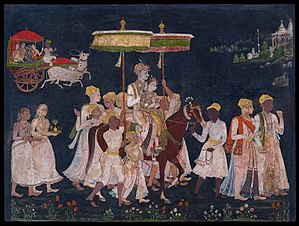Bhagmati

Bhagamati (Hyder Mahal) was a queen of Sultan Muhammad Quli Qutb Shah, in whose honor Hyderabad was supposedly named.[1] There exists debate among scholars about whether there existed any Bhagamati at all and whether she influenced the naming.[2][3]
Popular narrative[]
Bhagmati was born in 'Chichlam' (place not identified with certainty) in a Hindu family; she was a local nautch-girl.[2] Qutb Shah met her whilst riding out, fell in love to the extent of having constructed Purana Pul as a means of meeting her regularly, and entered into a marriage.[2][4] Accordingly, the sultan founded a city around her birth-place and named it "Bhaganagar" or "Bhāgyanagar" in her honor.[3] After she converted to Islam and adopted the title Hyder Mahal, the city was renamed Hyderabad.[4]
Scholarly debates[]
That Purana Pul was completed in 1578 after 2 years of construction; Qutb Shah (b:1566) was romancing Bhagmati as young as ten years.[2] Furthermore, no tomb was built over her last remains unlike other leading female figures of the court; no inscription or coin of that period mentions her name.[2][3] The chroniclers who mentioned of her were either from North of the Sultanate, who did not visit Hyderabad or foreigners, who arrived long after her death; contemporary Deccani sources including Qutb Shah himself don't mention of her at all.[3][4] The conferral of 'Hyder', an immensely sacred Islamic attribute on a nautch-girl has been doubted as well.[2][4] All these cast significant doubts on the authenticity of Bhagmati's existence.[3]
Some however assert that the historicity of multiple sources can't be rejected as hearsay due to their foreign nature, sources exist in that the State Museum in Public Gardens has a portrait of her commissioned around 1750, and that her conspicuous absence from Deccani sources were a result of damnatio memoriae.[3][4] Others believe Bhagnagar (which was indeed named after her) was a separate village which has nothing to do with today's Hyderabad.[3]
References[]
- ^ "Hyderabad or Bhagyanagar? The tiff continues". Deccan Chronicle. 29 April 2014. Retrieved 16 December 2020.
- ^ a b c d e f Ifthekhar, J. S. (11 November 2013). "Did Bhagmati really exist?". The Hindu. ISSN 0971-751X. Retrieved 16 December 2020.
- ^ a b c d e f g Ayoob Ali Khan, Mir (22 March 2010). "For Hyderabadis, Bhagmati is vital part of history | Hyderabad News - Times of India". The Times of India. Retrieved 16 December 2020.
- ^ a b c d e Pillai, Manu S. (15 November 2018). "Opinion | A Hyderabadi conundrum". LiveMint. Retrieved 16 December 2020.
- People from Hyderabad State
- Indian queen consorts
- Qutb Shahi dynasty
- Telugu people
- 16th-century Indian women
- 16th-century Indian people